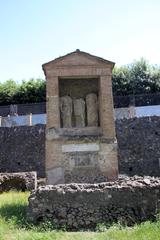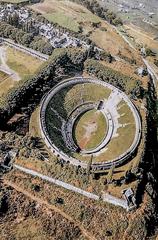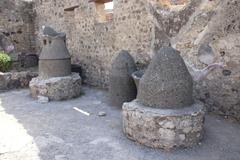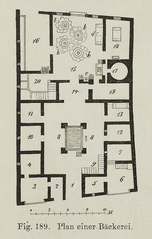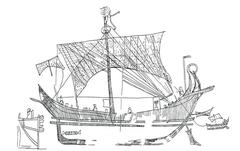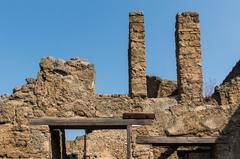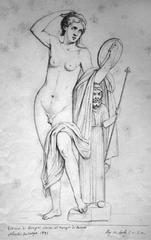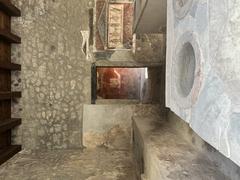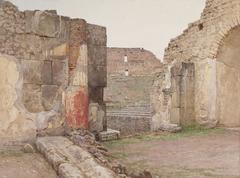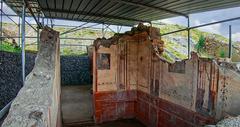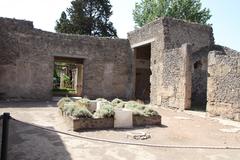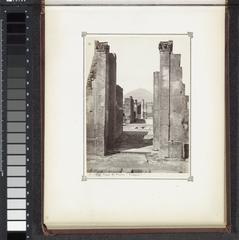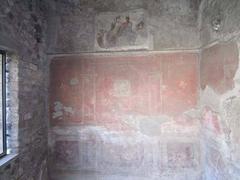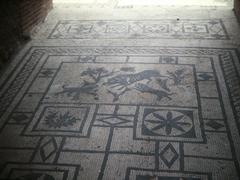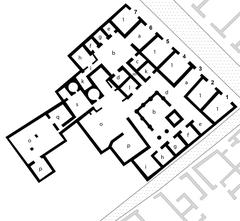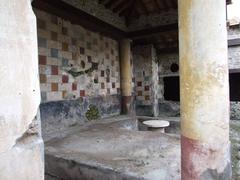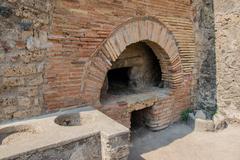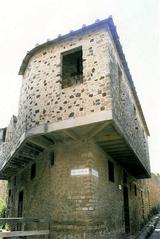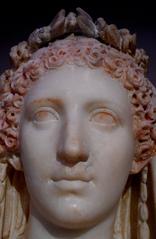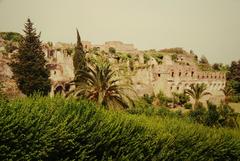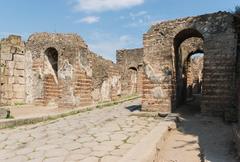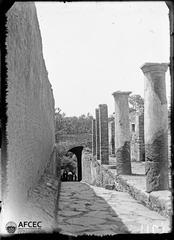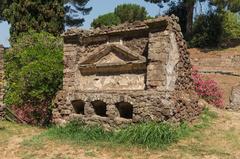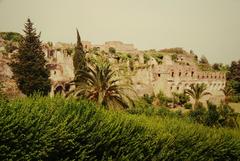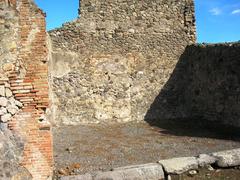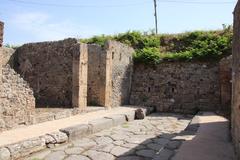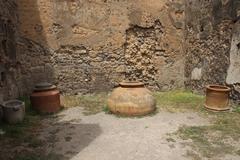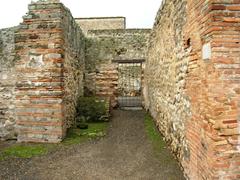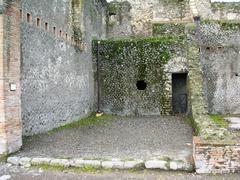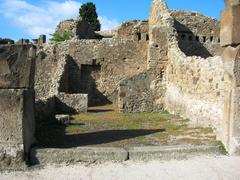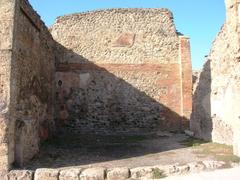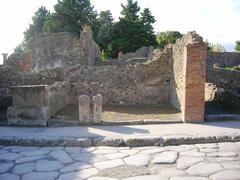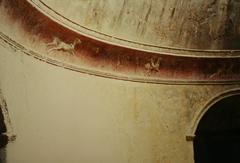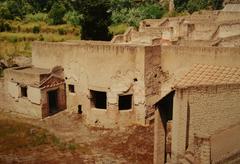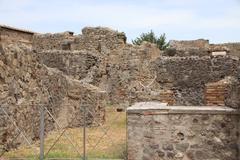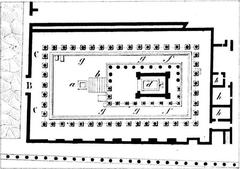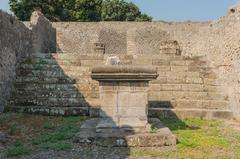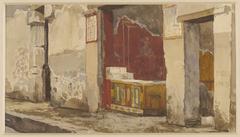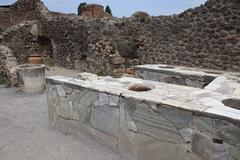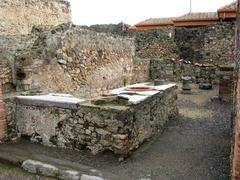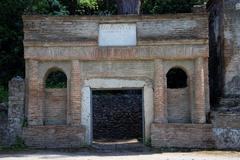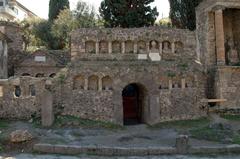
Comprehensive Guide to Visiting Pompeii, Pompei, Italy
Date: 13/08/2024
A Bold Beginning
Picture this: a vibrant Roman city, bustling with life, suddenly paused as if in a freeze-frame by a catastrophic volcanic eruption. Welcome to Pompeii, an ancient city nestled by the Gulf of Naples in Italy, where every cobblestone and fresco whispers tales of the past. In August 79 CE, Mount Vesuvius erupted, encapsulating Pompeii under layers of ash and pumice, creating an accidental time capsule that offers an unparalleled glimpse into Roman life (The Collector). As you wander through its well-preserved streets, villas, and public spaces, you’ll find yourself transported back nearly two millennia, experiencing firsthand the grandeur and everyday realities of a bygone era. Whether it’s the haunting plaster casts of its inhabitants or the intricate mosaics that adorned its homes, Pompeii is a vivid narrative frozen in ash, waiting for you to uncover its secrets.
Table of Contents
- History of Pompeii
- Welcome to Pompeii: A City Frozen in Time
- Nature’s Fury: The Eruption of Mount Vesuvius
- Preserved in Ash: A Snapshot of Roman Life
- The Rediscovery: Unearthing the Past
- Hidden Treasures: Recent Discoveries
- Why Pompeii Matters: A Window to the Past
- Must-See Marvels: Key Structures and Artifacts
- Human Stories: Anthropological Insights
- Preserving the Past: Modern Archaeological Efforts
- Significance of Pompeii
- Introduction
- Historical Context
- Archaeological Importance
- Preservation of Roman Life
- UNESCO World Heritage Site
- Cultural and Educational Value
- Influence on Modern Archaeology
- Tourism and Economic Impact
- Challenges and Preservation Efforts
- Educational Programs and Research
- Visitor Experience
- Practical Tips for Visitors
- Seasonal Highlights
- Myth Busting and Surprises
- Local Secrets and Hidden Gems
- Frequently Asked Questions (FAQ)
- Visitor Tips for a Memorable Experience
History of Pompeii
Welcome to Pompeii: A City Frozen in Time
Imagine this: a bustling, vibrant city, brimming with life, suddenly frozen in a moment of time. Welcome to Pompeii, a place where the past comes alive! Nestled on the picturesque Gulf of Naples in Italy, Pompeii was once a thriving hub of the Roman Empire. With an estimated population of 10,000 to 20,000, it boasted sophisticated infrastructure, from advanced aqueducts to luxurious villas. A bustling port city, Pompeii was a melting pot of trade and culture, making it a jewel of the Mediterranean.
Nature’s Fury: The Eruption of Mount Vesuvius
Let’s set the scene: It’s August 24, 79 CE. Suddenly, Mount Vesuvius erupts with fury, spewing a 10-mile-high column of ash and pumice into the sky. For 24 hours, Pompeii and nearby towns like Herculaneum are buried under volcanic debris. Pyroclastic flows—imagine fast-moving avalanches of hot gas and volcanic rock—engulf the city, claiming around 2,000 lives in Pompeii and 14,000 more in the surrounding areas (The Collector).
Preserved in Ash: A Snapshot of Roman Life
The ash and pumice that smothered Pompeii acted like a time capsule, preserving buildings, artifacts, and even the unfortunate victims in eerie detail. This has given us an unparalleled glimpse into Roman life in the first century CE. Archaeologists have unearthed homes, shops, public baths, and even graffiti, painting a vivid picture of daily life in ancient Pompeii (The Roman Guy).
The Rediscovery: Unearthing the Past
Pompeii lay forgotten until the late 16th century. Systematic excavations began in 1748 under the guidance of Spanish engineer Rocque Joaquin de Alcubierre. These early digs were more about treasure hunting than preservation, but by the 19th and 20th centuries, a more scientific approach took over, unveiling the extensive archaeological site we marvel at today (CNN).
Hidden Treasures: Recent Discoveries
Pompeii continues to reveal its secrets. In 2024, archaeologists discovered the remains of a man and a woman in a small bedroom in Region IX. The woman clutched a cache of gold, silver, and bronze coins, as well as jewelry—suggesting they were trying to escape with their valuables (VOA News).
Why Pompeii Matters: A Window to the Past
Pompeii is among the world’s most significant archaeological sites, offering a detailed snapshot of Roman urban life. From grand public buildings to intimate private homes, the artifacts and structures uncovered provide invaluable insights into Roman architecture, social structure, and daily activities.
Must-See Marvels: Key Structures and Artifacts
The Amphitheater
Ever seen an ancient stadium? Pompeii’s amphitheater is the oldest known, holding up to 20,000 spectators. It hosted gladiatorial games and public spectacles, rivaling Rome’s Colosseum (The Roman Guy).
The Forum
The Forum was Pompeii’s beating heart, a marketplace and political hub surrounded by the Basilica, temples, and public offices.
The House of the Faun
This grand residence is famous for its elaborate mosaics, including the ‘Alexander Mosaic,’ depicting Alexander the Great’s victory over Darius III of Persia.
The Villa of the Mysteries
On Pompeii’s outskirts, this villa is famed for its well-preserved frescoes depicting the initiation rites of the cult of Dionysus, offering a peek into ancient religious practices.
Human Stories: Anthropological Insights
The preserved remains of Pompeii’s victims provide a wealth of anthropological data. Studies reveal their health, diet, and lifestyles. For instance, dental analysis shows a diet rich in fruits and vegetables but also dental issues from coarse bread made with stone-ground flour (The Collector).
Preserving the Past: Modern Archaeological Efforts
Today’s archaeologists focus on excavation, preservation, and restoration. Challenges like weathering, tourism, and vandalism threaten the site. Recent projects aim to stabilize structures, restore frescoes, and improve visitor facilities to ensure Pompeii’s longevity (Independent).
Conclusion: An Invitation to Explore
Pompeii’s story is a poignant reminder of life’s fragility in the face of nature’s power. This ancient city, preserved in a moment of catastrophe, offers an extraordinary window into the past. As archaeological efforts continue, Pompeii remains a vital source of knowledge, captivating scholars and visitors alike. Ready to explore? Download the Audiala tour guide app to unlock Pompeii’s secrets and stories. Your adventure awaits!
Significance of Pompeii
Introduction
Imagine a bustling Roman city, frozen in time by a catastrophic volcanic eruption—this is Pompeii, a city that offers a rare, unaltered glimpse into ancient Roman life. Prepare yourself for a time-traveling adventure as we journey through the streets, homes, and lives of this ancient city.
Historical Context
Ready to hop in our time machine and zip back to 79 AD? Buckle up, because this is going to be one heck of a ride through ancient Pompeii! Located near modern-day Naples, Italy, Pompeii was a thriving Roman city until it was catastrophically buried under volcanic ash and pumice following the eruption of Mount Vesuvius in 79 AD. This event preserved the city in a state of suspended animation, providing an unparalleled snapshot of Roman life. The rediscovery of Pompeii in 1748 by a surveying engineer marked the beginning of extensive archaeological excavations that continue to this day (National Geographic).
Archaeological Importance
Pompeii is the longest continually excavated archaeological site in the world, making it a cornerstone for the development of archaeological methods and practices. Early excavations focused on unearthing buildings and streets as they stood at the time of the eruption, while modern archaeology aims to understand the city’s development over time (National Geographic). The site has been instrumental in shaping archaeological, art historical, conservation, and interpretation practices in Europe and beyond (UNESCO).
Preservation of Roman Life
The eruption of Mount Vesuvius preserved Pompeii in remarkable detail, offering a vivid picture of Roman society and daily life. The city’s layout, buildings, art, artifacts, and even the bodies of its inhabitants provide a unique window into the past. Imagine the vibrant colors of frescoes, the bustling sounds of the market, the aroma of baked bread wafting through the air, and the feel of the cobblestone streets underfoot. The plaster casts of the victims, created by pouring plaster into the voids left by decomposed bodies, are particularly poignant, capturing the final moments of the city’s residents (Krista the Explorer).
UNESCO World Heritage Site
Pompeii, along with Herculaneum and Torre Annunziata, is a UNESCO World Heritage Site. The vast expanse of Pompeii contrasts with the smaller but better-preserved remains of Herculaneum, while the superb wall paintings of the Villa Oplontis at Torre Annunziata give a vivid impression of the opulent lifestyle enjoyed by the wealthier citizens of the early Roman Empire (UNESCO).
Cultural and Educational Value
Pompeii’s significance extends beyond its archaeological value; it serves as an educational resource and a cultural touchstone. The site offers insights into Roman architecture, urban planning, and social structure. Public buildings such as the Capitolium, the Basilica, and various temples, as well as public bath complexes, theatres, and an amphitheatre, illustrate the complexity and sophistication of Roman urban life (UNESCO).
Influence on Modern Archaeology
Pompeii has been a testing ground for every step in the development of archaeological science. From early treasure hunting to modern, systematic excavations, the site has seen a range of methodologies with varying degrees of success. Today, archaeologists are interested in understanding the city’s development, from its origins to its destruction, providing a comprehensive view of its historical significance (National Geographic).
Tourism and Economic Impact
Pompeii is one of the most visited archaeological sites in the world, attracting millions of tourists annually. This influx of visitors has a significant economic impact on the region, contributing to the local economy through tourism-related activities. However, the high volume of visitors also poses challenges for site management and preservation (Walks of Italy).
Challenges and Preservation Efforts
The preservation of Pompeii is an ongoing challenge. The site is exposed to natural elements, and the sheer number of visitors can cause wear and tear. Efforts to preserve and protect the site include controlled excavations, restoration projects, and the implementation of visitor management strategies. UNESCO and other organizations continue to work towards maintaining the site’s integrity while making it accessible to the public (UNESCO).
Educational Programs and Research
Pompeii serves as a living laboratory for students and researchers from around the world. Educational programs and research initiatives focus on various aspects of the site, from its architecture and art to its social and economic history. These programs not only contribute to our understanding of Pompeii but also help train the next generation of archaeologists and historians (National Geographic).
Visitor Experience
Visiting Pompeii is a unique experience that allows tourists to step back in time and explore a Roman city frozen in its final moments. The site is vast, covering 44 hectares, and includes numerous highlights such as the amphitheatre, the basilica, temples, and fora. Guided tours are highly recommended to provide context and enhance the visitor experience. Audio guides and maps are also available for those who prefer to explore independently (Time Travel Turtle).
Practical Tips for Visitors
To make the most of a visit to Pompeii, it is essential to plan ahead. The site is extensive, and exploring it can be physically demanding. Visitors should wear comfortable walking shoes, bring water, and use sun protection. It is advisable to visit early in the morning or later in the afternoon to avoid the crowds. There are three main entrances to the site, each with different facilities, so choosing the right entrance based on individual needs can enhance the experience (Walks of Italy).
Seasonal Highlights
Pompeii offers unique experiences throughout the year. In spring, the site is adorned with blooming flowers, while summer brings vibrant festivals and events that recreate ancient Roman traditions. Autumn offers cooler weather and fewer crowds, making it an ideal time for a leisurely exploration. Winter, though quieter, provides a peaceful and reflective atmosphere, perfect for those looking to delve deeper into history.
Myth Busting and Surprises
Did you know that Pompeii was not destroyed instantly by the eruption? Contrary to popular belief, the city experienced a series of eruptions over two days, allowing some residents to escape. Another surprising fact is that Pompeii had an advanced water system, with lead pipes supplying water to homes and public baths. These insights challenge common misconceptions and reveal the city’s sophisticated infrastructure.
Local Secrets and Hidden Gems
Beyond the well-trodden paths, Pompeii has hidden gems waiting to be discovered. Visit the House of the Vettii, a luxurious residence with stunning frescoes that offer a glimpse into the lives of the elite. Explore the Lupanar, an ancient brothel with preserved erotic art that sheds light on the city’s social customs. Don’t miss the Villa of the Mysteries, located on the outskirts, where vivid frescoes depict mysterious initiation rites.
Frequently Asked Questions (FAQ)
Q: How long does it take to visit Pompeii? A: A thorough visit can take anywhere from 4 to 6 hours, depending on your level of interest and pace.
Q: Can you visit Pompeii and Herculaneum in one day? A: Yes, but it can be quite exhausting. Both sites are extensive, so it’s best to allocate a full day to each for a more relaxed experience.
Q: Is Pompeii wheelchair accessible? A: Some areas are accessible, but the uneven terrain and cobblestone streets can be challenging. It’s recommended to check with the site management for accessible routes.
Q: Are there guided tours available? A: Yes, guided tours are highly recommended to gain a deeper understanding of the site’s history and significance. Audio guides and maps are also available for independent exploration.
Q: What should I bring when visiting Pompeii? A: Comfortable walking shoes, water, sun protection, and a sense of adventure! Plan ahead and consider the weather conditions to ensure a pleasant visit.
Conclusion
Pompeii’s significance lies in its ability to provide a comprehensive and detailed picture of ancient Roman life. Its preservation under volcanic ash has made it an invaluable resource for archaeologists, historians, and tourists alike. As a UNESCO World Heritage Site, Pompeii continues to captivate the imagination of people around the world, offering a unique glimpse into a moment frozen in time. The ongoing efforts to preserve and study the site ensure that its legacy will endure for future generations to explore and appreciate. Before you embark on your Pompeii adventure, make sure to download Audiala. Our app will be your personal guide, revealing hidden gems and untold stories that even the most seasoned travelers might miss. Don’t just visit Pompeii—unlock its secrets with Audiala!
Visitor Tips for a Memorable Experience
Welcome to Pompeii: A Journey Through Time
Imagine stepping back nearly 2,000 years into a bustling Roman city frozen in time. Pompeii, with its haunting ruins and poignant stories, offers a rare glimpse into ancient life. Ready for an adventure? Let’s dive into some tips to make your visit unforgettable!
Planning Your Visit
Best Time to Visit
While summer (June to August) brings sunshine and crowds, savvy travelers know that spring (April to May) and fall (September to October) offer milder weather and fewer people. Picture yourself wandering the ancient streets in comfort, discovering hidden corners without the hustle and bustle (Untold Italy).
Opening Hours
From April to October, Pompeii is open from 9 am to 7 pm, with last entry at 5:30 pm. In winter (November to March), hours are 9 am to 5 pm, with last entry at 3:30 pm. Note that some houses may close earlier: after 6 pm in summer and 4:15 pm in winter (Helen on HerHolidays).
Ticketing
Avoid the lines and book your tickets in advance. Online options include standard entry and combined tickets for nearby sites like Herculaneum. The Campania Artecard is a gem for history buffs planning multiple site visits (The Geographical Cure).
What to Bring
Comfortable Walking Shoes
Pompeii’s cobblestone streets are charming but tricky. Sturdy, comfortable shoes will be your best friends as you navigate this ancient maze (Savoring Italy).
Sun Protection
With little shade on site, a wide-brimmed hat, sunglasses, and plenty of sunscreen are must-haves. An umbrella or parasol can also offer much-needed respite from the sun’s rays (Helen on Her Holidays).
Water and Snacks
Facilities are limited, so pack your own water and snacks. Staying hydrated is key, especially under the Mediterranean sun (Italy Beyond the Obvious).
Navigating the Site
Maps and Guides
Grab a free map at the entrance to navigate the sprawling site. The grid system can be a puzzle, but a map will lead you to all the must-see spots (Helen on Her Holidays).
Hiring a Guide
A guide can turn your visit into a storytelling adventure, bringing ancient Pompeii to life with fascinating tales and historical insights. Consider investing in a private tour for a rich, engaging experience (Italy Beyond the Obvious).
Key Attractions
The Amphitheater
Built in 80 BCE, this grand structure seated 12,000 spectators and is the oldest surviving Roman amphitheater. Imagine the roar of the crowd as you stand in this iconic arena (Planetware).
House of the Vettii
Step into the lives of two affluent brothers in this beautifully decorated home. The House of the Vettii offers a glimpse into the elegant lifestyles of Pompeii’s middle class (The Tour Guy).
The Forum
The heart of public life in Pompeii, the Forum, with its travertine paving and grand porticoes, is a must-see. Imagine the bustling activity as you stand in this central square (The Tour Guy).
Practical Considerations
Avoiding Crowds
Arrive early to beat the crowds and the midday heat. The early morning light casts a magical glow over the ruins, perfect for photography (Savoring Italy).
Accessibility
Pompeii’s terrain can be challenging, especially for those with mobility issues. Plan ahead and be prepared for a lot of walking on uneven surfaces (Helen on Her Holidays).
Responsible Tourism
Help preserve Pompeii’s legacy: dispose of trash properly, avoid touching the ruins, and respect fellow visitors. Your actions ensure that this historical treasure remains intact for future generations (Untold Italy).
Additional Tips
House of the Day Program
Unlock special access with the “House of the Day” program, offering a peek into homes usually closed to the public. Check the latest schedule on the Pompeii website for this unique opportunity (Helen on Her Holidays).
Combining Visits
Enhance your trip by visiting nearby sites like Herculaneum or Mount Vesuvius. Each location adds layers to your understanding of the region’s history and the volcanic eruption that shaped it (Untold Italy).
Local Lingo Lessons
Brush up on some Italian phrases to enrich your experience. Try greeting locals with a cheerful “Ciao!” (hello) or thanking them with a heartfelt “Grazie!” (thank you).
Sample Itineraries
Morning Explorer
- 9 am: Arrive early and start with the Amphitheater
- 10:30 am: Wander through the House of the Vettii
- 12 pm: Break at the Forum for a snack and some people-watching
Afternoon Adventurer
- 1 pm: Begin with a guided tour for historical insights
- 3 pm: Explore the lesser-known Villa of the Mysteries
- 4:30 pm: Relax and reflect at the Garden of the Fugitives
Myth Busting and Surprises
- Surprise Fact: Did you know that Pompeii had fast-food joints? Archaeologists have discovered ancient snack bars complete with frescoed menus!
Conclusion
Ready to embark on your Pompeii adventure? Download the Audiala app for an interactive map, audio guides, and more tips to enhance your visit. Embrace the past and create unforgettable memories in this timeless city. Buon viaggio!
Invitation to Explore with Audiala
Pompeii is not just an archaeological site; it is a poignant reminder of the fragility of human life and the enduring power of nature. Preserved under volcanic ash, Pompeii serves as a time capsule, offering invaluable insights into the daily lives, social structures, and architectural marvels of ancient Rome (National Geographic). Its significance extends beyond history and archaeology, influencing modern conservation practices and continuing to captivate millions of visitors annually. As you prepare to explore Pompeii, consider downloading the Audiala app to enrich your journey with expert insights and hidden gems. Dive deep into the stories etched into the ruins and let Audiala guide you through this mesmerizing ancient city (VOA News). Buon viaggio!
References
- The Collector, 2024 source url
- The Roman Guy, 2024 source url
- CNN, 2024 source url
- VOA News, 2024 source url
- National Geographic, 2024 source url
- UNESCO, 2024 source url
- Krista the Explorer, 2024 source url
- Walks of Italy, 2024 source url
- Time Travel Turtle, 2024 source url
- Untold Italy, 2024 source url
- Helen on Her Holidays, 2024 source url
- The Geographical Cure, 2024 source url
- Savoring Italy, 2024 source url
- Italy Beyond the Obvious, 2024 source url
- Planetware, 2024 source url
- The Tour Guy, 2024 source url
